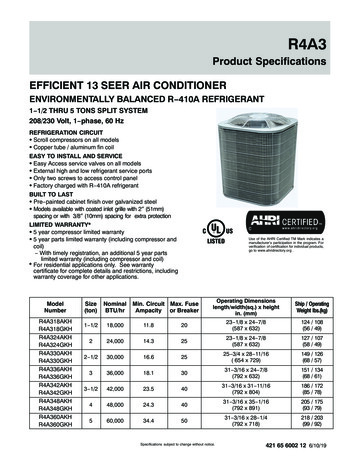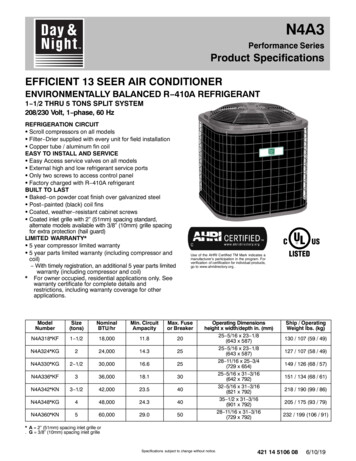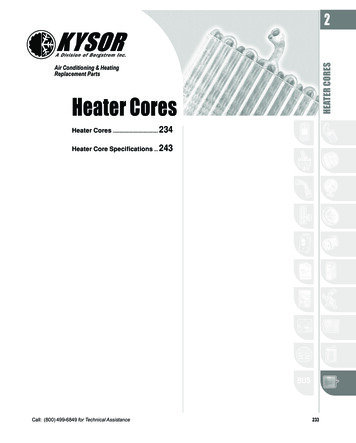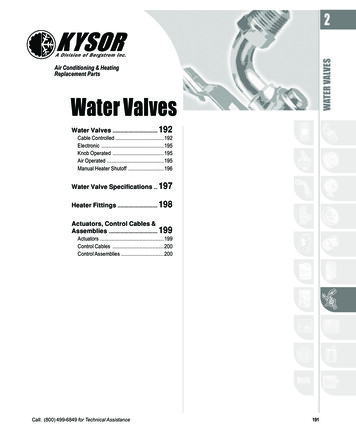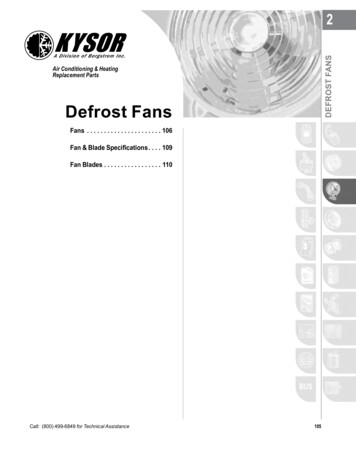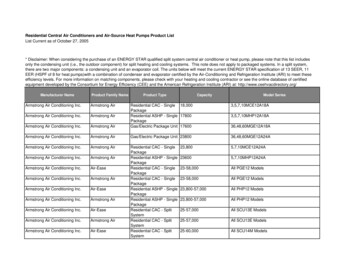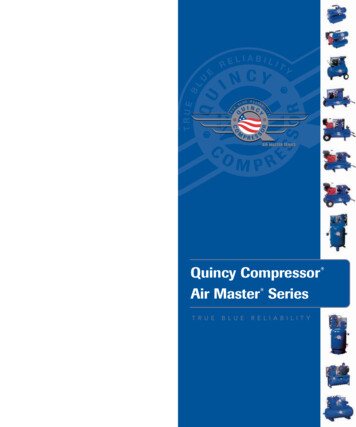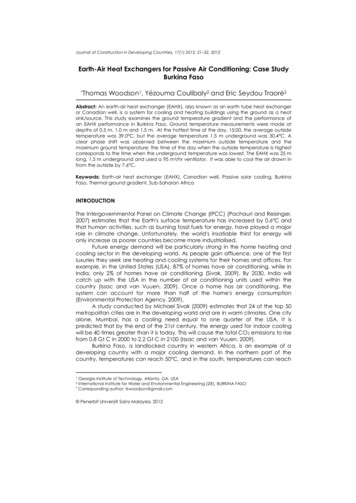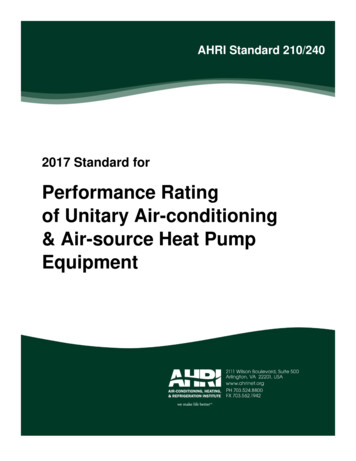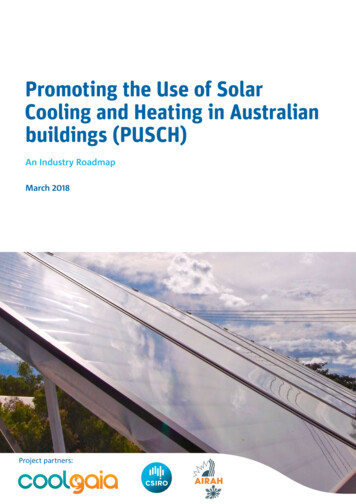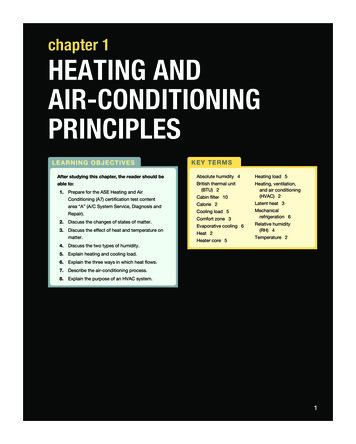
Transcription
chapter 1HEATING ANDAIR-CONDITIONINGPRINCIPLESLEARNING OBJECTIVESKEY TERMSAfter studying this chapter, the reader should beAbsolute humidity 4Heating load 5able to:British thermal unit(BTU) 2Heating, ventilation,and air conditioning(HVAC) 21.Prepare for the ASE Heating and AirConditioning (A7) certification test contentarea “A” (A/C System Service, Diagnosis andRepair).2.Discuss the changes of states of matter.3.Discuss the effect of heat and temperature onmatter.4.Discuss the two types of humidity.5.Explain heating and cooling load.6.Explain the three ways in which heat flows.7.Describe the air-conditioning process.8.Explain the purpose of an HVAC system.Cabin filter 10Calorie 2Latent heat 3Cooling load 5Mechanicalrefrigeration 6Comfort zone 3Evaporative cooling 6Heat 2Heater core 5Relative humidity(RH) 4Temperature 21M01 HALD3698 08 SE C01.indd 117/11/16 10:46 AM
?SOLIDLIQUIDFREQUENTLY ASKED QUESTIONWhy Is Liquid Sprayed from a Can Cold?VAPORIf a pressurized can of liquid is sprayed continuously,the can becomes cold, and so does the liquidbeing sprayed. The can becomes cold becausethe pressure in the can is reduced while spraying,allowing the liquid propellant inside the can to boiland absorb heat. The propellant vapor is furthercooled as it decompresses when it hits the open air.FIGURE 1–1 Water is a substance that can be foundnaturally in solid, liquid, and vapor states.Rapid decompression results in a rapid temperaturedrop.INTRODUCTIONmeans that changes can be observed between liquidwater and ice under normal weather conditions.PURPOSE AND FUNCTIONThe heating, ventilation, A liquid is a substance that cannot be compressed. Aand air-conditioning (HVAC) system of an automobile issubstance in a liquid state has a fixed volume, but nodesigned to provide comfort for the driver and passengers. Itdefinite shape.is intended to maintain in-vehicle temperature and humidity within a range that is comfortable for the people inside andThe boiling point is the temperature at which a liquidsubstance turns to vapor. For water at normal sea levelprovide fresh, clean air. The air-conditioning system transfersconditions, the boiling point is 212 F (100 C). A vapor isthe heat from inside the vehicle and moves it to the outside ofa substance that can be easily compressed, has no resis-the vehicle. The heater is needed in cold climates to preventtance to flow, and no fixed volume. Since a vapor flows,freezing or death.it is considered a fluid just like liquids are.PRINCIPLES INVOLVEDOn earth, matter is found in oneof three different phases or states:1. SolidA vapor condenses to liquid if the temperature falls below thevaporizing temperature. Again, the difference is simply whetherheat is being added or taken away. Boiling point and condensation point temperatures are not fixed because they vary with2. Liquidpressure.3. Vapor (gas)The state depends upon the nature of the substance, theHEAT AND TEMPERATUREtemperature, and the pressure or force exerted on it. Watertend to vibrate rapidly in all directions, and this disorganizedoccurs naturally in all three states: solid ice, liquid water, andenergy is called heat. The intensity of vibration depends on howwater vapor, depending upon the temperature and pressure.much kinetic energy, or energy of motion, the atom or molecule SEEcontains. Heat and temperature are not the same.FIGURE 1–1.CHANGES OF STATE A solid is a substance that cannotbe compressed and has strong resistance to flow. Themolecules of a solid attract each other strongly, and resistchanges in volume and shape. 2Molecules in a substanceTemperature is the measure of the level of energy.Temperature is measured in degrees. Heat is measured in the metric unit called calorie andexpresses the amount of heat needed to raise thetemperature of one gram of water one degree Celsius.A substance is solid at any temperature below its meltingHeat is also measured in British Thermal Units (BTU).point. Melting point is a characteristic of the substance,One BTU is the heat required to raise the temperatureand is related to the temperature at which a solid turnsof one pound of water 1 F at sea level. One BTU equalsto liquid. For water, the melting point is 32 F (0 C), which252 calories.CHAPTER 1M01 HALD3698 08 SE C01.indd 217/11/16 10:46 AM
HEAT212 F212 F212 F212 F1 GRAM WATER 540 CALORIES 1 GRAM VAPOR1 POUND WATER 970 BTUs 1 POUND VAPORFIGURE 1–2 The extra heat required to change a standardamount of water at its boiling point to vapor is called latentheat of vaporization.SENSIBLE HEATHEAT212 F1 GRAM OF VAPOR – 540 CALORIES 1 GRAM WATER1 POUND OF VAPOR – 970 BTUs 1 POUND WATERFIGURE 1–3 The latent heat of vaporization that water vaporstores is released when the vapor condenses to a liquid. Thetemperature stays the same.Sensible heat makes sense because itcan be felt and measured on a thermometer. If there is 1 lb. ofwater at 40 F and 1 BTU of heat is added to it, the temperaturewill increase to 41 F. Adding another BTU of heat will increasemore energetically with the walls of the container. Conversely,the temperature to 42 F and adding another 170 BTU (212–42)decreasing the temperature decreases the pressure. Thiswill increase the temperature to 212 F, the boiling point.relationship between temperature and pressure in vapor is whya can of nonflammable refrigerant can explode when heatedLATENT HEATLatent heat is the “extra” heat that isby a flame—the pressure buildup inside the can will eventuallyneeded to transform a substance from one state to another.exceed the can's ability to contain the pressure. Increasing theImagine that a solid or a liquid is being heated on a stove.pressure by compressing vapor increases the temperature.When the solid reaches its melting point, or the liquid reachesDecreasing the pressure by permitting the vapor to expandits boiling point, their temperatures stop rising. The solid beginsdecreases the temperature.to melt, and the liquid begins to boil. This occurs without anysensible change in temperature, even though heat is still beingHEAT INTENSITYapplied from the burner. The water in the container on thebecause if it is too cold, humans feel uncomfortable and isstove boils at a temperature of 212 F (100 C) at sea level, formeasured in degrees. Extremely cold temperatures can causeas long as any liquid water remains. As heat is further added tofrostbite and hypothermia. The other end of the scale can alsothe water, heat will be used in changing the state of the liquidbe uncomfortable and may cause heat stress and dehydration.to a vapor. This extra, hidden amount of energy necessary toHumans have a temperature comfort zone somewherechange the state of a substance is called latent heat. SEEbetween 68 F and 78 F (20 C and 26 C). This comfort zoneFIGURES 1–2 AND 1–3.varies among individuals. SEE FIGURE 1–4.Latent heat is important in the operation of an airconditioning system because the cooling effect is derived fromRULESchanging the state of liquid refrigerant to vapor. The liquidconditioning must follow the basic rules of heat transfer. Anrefrigerant absorbs the latent heat of vaporization, makingunderstanding of these rules helps greatly in understanding thethe air cooler. The cooler air is then blown into the passengersystems.compartment.TEMPERATURE, VOLUME, AND PRESSURE OFA VAPOR Unlike a solid, vapor has no fixed volume.Increasing the temperature of a vapor, while keeping thevolume confined in the same space, increases the pressure.This happens as the vibrating vapor molecules collide more and OFHEATIntensity of heat is important to usTRANSFERHeatingandHeat always flows from hot to cold. (From higher level ofenergy to lower level of energy.) SEE FIGURE 1–5. To warm a person or item, heat must be added. To cool a person or item, heat must be removed. A large amount of heat is absorbed when a liquidchanges state to vapor.H eati n g a n d Air -C o n dition in g P ri n ciplesM01 HALD3698 08 SE C01.indd 3air317/11/16 10:46 AM
TECH TIPQuick and Easy Temperature ConversionTemperature in service information and on scan toolsis often expressed in degrees Celsius, which is oftenconfusing to those used to temperatureexpressed in Fahrenheit degrees. A quick and easyway to get an approximate conversion is to take thedegrees in Celsius, double it, and add 25.For example,Celsius 2 25 approximate Fahrenheitdegrees:0 C 2 0 25 25 F (actual 32 F)10 C 2 20 25 45 F (actual 50 F)15 C 2 30 25 55 F (actual 59 F)20 C 2 40 25 65 F (actual 68 F)25 C 2 50 25 75 F (actual 77 F)30 C 2 60 25 85 F (actual 86 F)35 C 2 70 25 95 F (actual 95 F)40 C 2 80 25 105 F (actual 104 F)45 C 2 90 25 115 F (actual 113 F)50 C 2 100 25 125 F (actual 122 F)The simplest way to convert between the Fahrenheitand Celsius scales accurately is to use a conversionFIGURE 1–4 Heat intensity is measured using athermometer. The two common measuring scales, Celsiusand Fahrenheit, are shown here. This thermometer is alsomarked with water freezing and boiling and refrigerant boilingtemperatures.chart or use an app on a smart phone. A large amount of heat is released when a vapor changesstate to a liquid. Compressing a gas concentrates the heat and increasesthe temperature.HUMIDITYHumidity refers to water vapor present in theair. The level of humidity depends upon the amount of watervapor present and the temperature of the air. The amountof water vapor in the air tends to be higher near lakes or theocean, because more water is available to evaporate from theirHOT TRAVELS TO COLD UNTILTHE TEMPERATURES EQUAL.surfaces. In desert areas with little open water, the amount ofwater vapor in the air tends to be low. Absolute humidity is the measure of the amountof moisture (water vapor) in the air regardless of thetemperature. Relative humidity (RH) is the percentage of how muchmoisture is present in the air compared to how muchmoisture the air is capable of holding at that temperature.FIGURE 1–5 Heat travels from higher temperature (higherenergy level), to lower temperature (lower energy level).4Relative humidity is commonly measured with a hygrometer or a psychrometer. A hygrometer depends on a sensitiveCHAPTER 1M01 HALD3698 08 SE C01.indd 417/11/16 10:46 AM
?FREQUENTLY ASKED QUESTIONWhat Is a Sling Pyschrometer?A psychrometer is a measuring instrument used tomeasure relative humidity. It uses two thermometers,one of which has the bulb covered in a cotton wicksoaked in distilled water from a built in reservoir.The wick keeps the bulb of the “wet thermometer”wet so that it can be cooled by evaporation. Slingpsychrometers are spun round in the air a certainnumber of times. Water evaporates from the cottonwick at a rate inversely proportional to the relativehumidity of the air.FIGURE 1–6 A combination meter that measures and displays both the temperature and the humidity is useful to usewhen working on air-conditioning systems. Faster if the humidity is low. Slower if the humidity is high.The “dry thermometer” measures the air temperature. The higher the relative humidity, the closer thereadings of the two thermometers.element that expands and contracts, based on the humidity.Hygrometers typically resemble a clock, with the scale readingfrom 0% to 100% relative humidity. SEE FIGURE 1–6. The lower the humidity, the greater the differencein temperature of the two thermometers.The different temperatures indicated by the wetand dry thermometers are compared to values givenin a chart, which gives the relative humidity. Whilea sling psychrometer is still used, most techniciansHEATING AND COOLINGLOADHEATING LOADuse an electronic instrument to measure relativehumidity. SEE FIGURE 1–7.Heating load is the term used whenDRY THERMOMETERadditional heat is needed. The actual load is the number ofBTUs or calories of heat energy that must be added. In a homeor office, burning fuel is the usual way to generate heat usingcoal, gas, or oil as a fuel. In most vehicles, the heat is providedby the heated coolant from the engine cooling system. Thiscoolant is typically at a temperature of 190 F to 205 F (88 Cto 98 C) when the engine reaches its normal operatingtemperature. SEE FIGURE 1–8.WATERFILL PLUGWET THERMOMETERIn most vehicles, heated coolant is circulated through aheat exchanger, called a heater core. Air is circulated throughthe heater core, where it absorbs heat. Then it is blown into thepassenger compartment, where the heat travels on to warmthe car interior and occupants. The air from the blower motormoves the heat from the heater core to the passengers.COOLING WITH ICEOne way to move heat, calledFIGURE 1–7 A sling psychrometer is used to measurerelative humidity.cooling load, is with a block of ice. A substantial amount ofH eati n g a n d Air -C o n dition in g P ri n ciplesM01 HALD3698 08 SE C01.indd 5517/11/16 10:46 AM
HEATING LOADCOOLING LOADSUNRAINWINDHIGHHUMIDITYFIGURE 1–9 Ice has a cooling effect because of latent heatof fusion which means that it absorbs heat as it melts.SNOWICEENGINE ANDEXHAUSTFIGURE 1–8 Winter presents a heat load where heat must beadded for comfort (right). Summer presents a cooling load.latent heat is required to change the state of the solid ice intoFIGURE 1–10 At one time, evaporative coolers were usedto cool car interiors. Air forced through a water-wetted meshproduces evaporation and a cooling effect.a liquid: 144 BTU per lb. (80 calories per gram). A 50-lb. block of ice represents 50 144, or 7,200 BTU,of cooling power when it changes from 50 lb. of solid at32 F to 50 lb. of liquid at 32 F.In the early days of air conditioning, the term ton wascommonly used. A ton of air conditioning was the amount ofcooled. Disadvantages of evaporative coolers, often called“swamp coolers” includes: increases the relative humidly not effective in areas of high humidity because the waterdoes not evaporate rapidly enough to
Repair). 2. Discuss the changes of states of matter. 3. Discuss the effect of heat and temperature on matter. 4. Discuss the two types of humidity. 5. Explain heating and cooling load. 6. Explain the three ways in which heat flows. 7. Describe the air-conditioning process. 8. Explain the purpose of an HVAC system. LEARNING OBJECTIVES M01_HALD3698_08_SE_C01.indd 1 17/11/16 10:46 AM. 2

